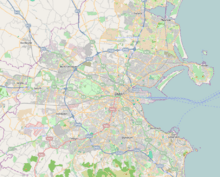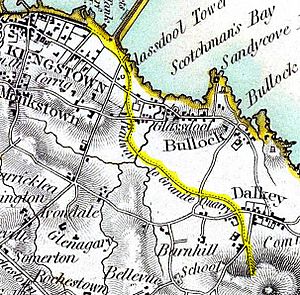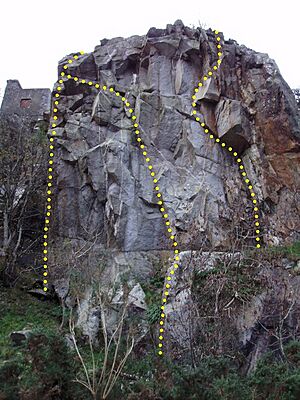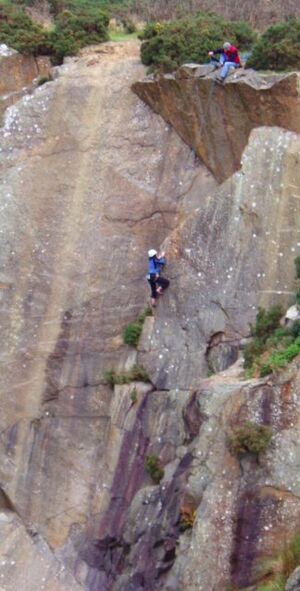Dalkey Quarry facts for kids
Quick facts for kids Dalkey Quarry |
|
|---|---|
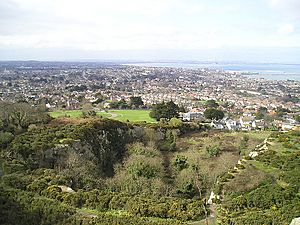
Dalkey Quarry, looking north and down into the quarry, over the upper tier and west valley sections
|
|
| Location | Dalkey Hill, Dalkey, Co. Dublin |
| Nearest city | Dublin City |
| Coordinates | 53°16′16″N 6°06′25″W / 53.2711°N 6.1069°W |
| Climbing type |
|
| Height | circa 35 metres at its highest |
| Pitches | Single pitch |
| Ratings |
|
| Rock type | Granite |
| Quantity of rock |
|
| Development | Located in a public park; 10 minutes walk from Dalkey DART station |
| Cliff aspect | Multiple aspects |
| Ownership | Public park |
| Camping | Camping is not allowed |
| Classic climbs | |
Dalkey Quarry (pronounced DAW-kee) is an old granite quarry found on Dalkey Hill in Dalkey, a suburb of Dublin, Ireland. It stopped being used in the 19th century. Today, it's one of the most popular places for rock climbing in Ireland. It has over 350 climbing routes, and some of them are among the toughest single-pitch climbs in the country.
Contents
A Look Back: History of Dalkey Quarry
Quarrying at Dalkey Hill began around 1815. Workers dug out granite to help build the new harbour pier in nearby Dún Laoghaire. This stone was also used for the South Bull Wall, which protects Dublin Harbour, and for paving streets in Dublin.
In the 1840s, some of the quarry's stone was even sent to Newfoundland. It was used to build the Basilica of St. John the Baptist there. The quarry had a small railway that connected it to Dún Laoghaire. Part of this old railway path is now a public footpath called The Metals. You can still see some of the original granite paving.
Quarrying continued off and on until 1917, when it finally stopped.
From Quarry to Park
In 1914, most of the quarry land became part of Killiney Hill Park. This opened it up for everyone to enjoy.
Later, in 1998, there were plans to turn part of the quarry into a caravan site. However, people living nearby, climbers, and environmental groups did not agree with this idea. Because of their strong opposition, the plans were eventually stopped.
In 2010, the local council removed some large boulders from the quarry. This upset climbers because it changed some climbing routes and could have damaged others.
Exploring Dalkey Quarry: Layout and Access
Dalkey Quarry has three main areas for climbing. You can get to them from Ardbrugh Road, which is off Dalkey Avenue.
- The Far East Valley is private land and closed to climbers.
- The East Valley Climbing Area has several climbing routes.
- The West Valley Climbing Area also offers many climbs.
Between the East and West valleys, there's a wide ridge. This is where the old quarry railway used to run. This ridge helps climbers reach the Upper Cliffs (or Tier) Climbing Area. This area has the quarry's tallest cliffs.
Paths and Nature
A paved path crosses the Upper Cliffs area. It leads to the Killiney Hill car park on one side and steps to the top of the hill on the other. This path and the steps are popular with people out for a walk. A wall runs along the top of the cliffs, next to the hilltop path. You'll also see an old signaling tower there. The British military used it in the 19th century to send signals to nearby Martello towers.
The quarry is mostly left wild, not landscaped. It's like a forest, with lots of gorse and bramble plants. This makes it look more natural than a typical industrial quarry. Many animals live here, including foxes. In recent years, peregrine falcons have made their nests in the upper cliffs. When they are nesting, climbing near their nests is not allowed to protect the birds.
Rock Climbing at Dalkey Quarry
The first recorded climbs at Dalkey Quarry happened in 1942. Members of the Irish Mountaineering Club (IMC) made these climbs. They even published a handwritten guidebook. These were important first steps for rock climbing in Ireland. Many of those original climbing routes are still used by climbers today.
Over the years, more climbers helped clear plants and loose rocks. This uncovered even more climbing routes. Also, climbing techniques and equipment got better, leading to harder grades for climbs.
Routes and Popularity
The latest guidebook, from 2005, lists about 300 routes. The online guidebook has over 350 routes. Dalkey Quarry has many routes packed into a small area. This is because it's the easiest outdoor rock climbing spot to reach from Dublin city. Many climbers and local clubs use the quarry. Some of these clubs include The Irish Mountaineering Club (IMC), Club Cualann, and Dublin Cliffhangers Youth Climbing Club.
Most routes at Dalkey Quarry are single-pitch, meaning they are one continuous climb. They are usually between 10 and 35 meters long. The routes vary a lot. Some have steep cracks for fingers, while others are smooth, bare rock slabs. The rock is granite, which usually provides good grip. However, because it was quarried, it's not as rough as natural granite.
Safety and Ethics
Protection for climbers is generally good. In Dalkey Quarry, climbers follow a rule: no bolts are placed on climbs. The few old metal spikes called pitons that are left are rarely replaced if they break. This keeps the climbing experience more traditional.
See also


